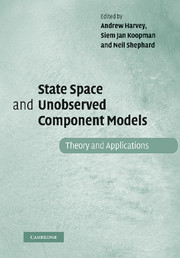Book contents
- Frontmatter
- Contents
- Preface
- Acknowledgements
- Part I State space models
- 1 Introduction to state space time series analysis
- 2 State structure, decision making and related issues
- 3 An introduction to particle filters
- Part II Testing
- Part III Bayesian inference and bootstrap
- Part IV Applications
- References
- Author index
- Subject index
3 - An introduction to particle filters
Published online by Cambridge University Press: 06 January 2010
- Frontmatter
- Contents
- Preface
- Acknowledgements
- Part I State space models
- 1 Introduction to state space time series analysis
- 2 State structure, decision making and related issues
- 3 An introduction to particle filters
- Part II Testing
- Part III Bayesian inference and bootstrap
- Part IV Applications
- References
- Author index
- Subject index
Summary
Abstract
This paper introduces particle filtering to an audience who are more familiar with the Kalman filtering methodology. An example is used to draw comparisons and discuss differences between the two approaches and to motivate some avenues of current research.
Introduction
This paper introduces particle filtering to an audience that is unfamiliar with the literature. It compliments other introductions (Doucet, de Freitas and Gordon 2001) and tutorials (Arulampalam, Maskell, Gordon and Clapp 2002) with a contribution that appeals to intuition and documents an understanding that demystifies what can appear to be a much more complex subject than it truly is.
Particle filtering is a new statistical technique for sequentially updating estimates about a time evolving system as measurements are received. The approach has been developed in parallel by a number of different researchers and so is also known as: the CONDENSATION algorithm (Blake and Isard 1998), the bootstrap filter (Gordon, Salmond and Smith 1993), interacting particle approximations (Dan, Moral and Lyons 1999) and survival of the fittest (Kitagawa 1996). The approach opens the door to the analysis of time series using nonlinear non-Gaussian state space models. While linear Gaussian models can cope with a large variety of systems (e.g. Harvey (1989) and West and Harrison 1997)), nonlinear non-Gaussian models offer an even richer vocabulary with which to describe the evolution of a system and observations of this system.
Particle filtering is based on the idea that uncertainty over the value of a continuous random variable x can be represented using a probability density function, a pdf, p(x).
- Type
- Chapter
- Information
- State Space and Unobserved Component ModelsTheory and Applications, pp. 40 - 72Publisher: Cambridge University PressPrint publication year: 2004
- 5
- Cited by

